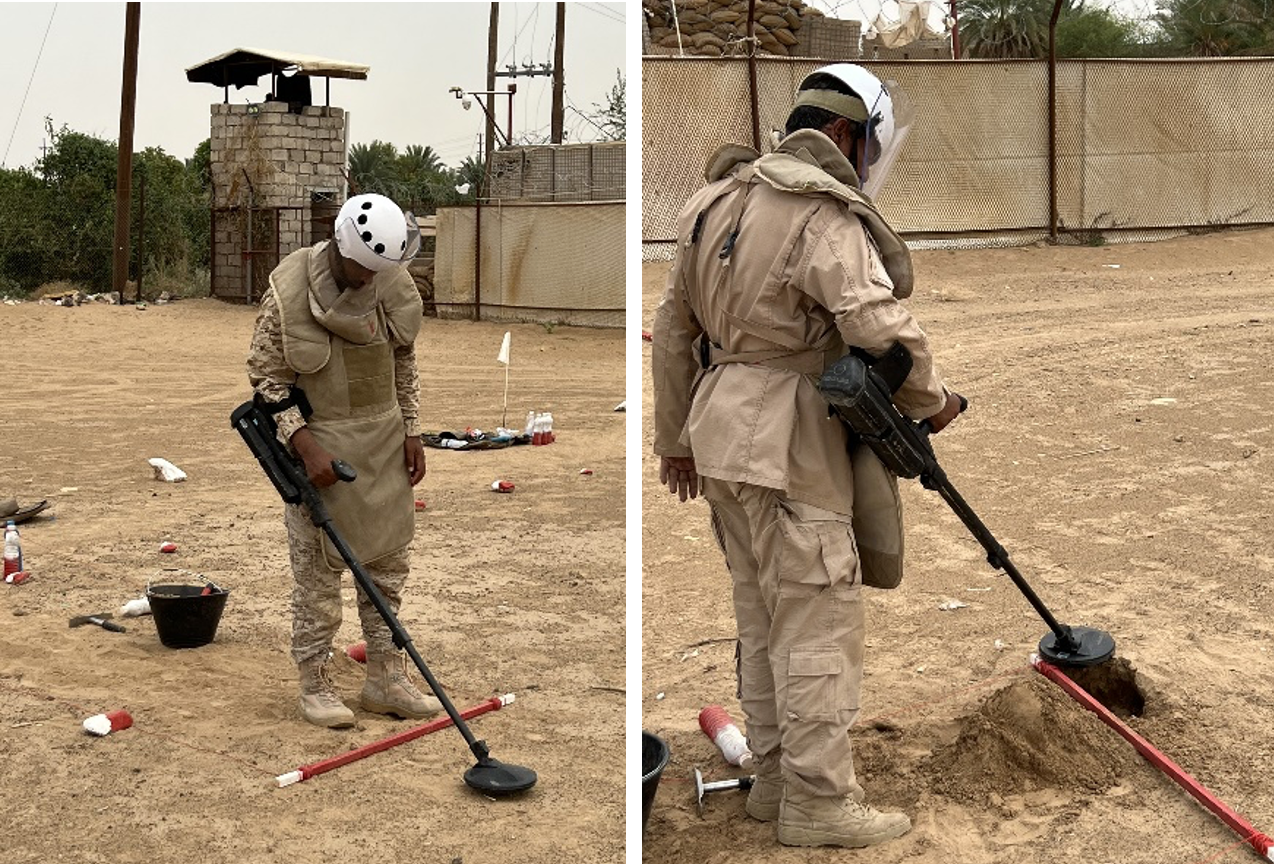They are between 28 and 47 years old, and all are attending classes with the same goal: to rid Yemen of landmines.
As Project Masam continues its life-saving humanitarian mine clearance work in the conflict-afflicted country, it is also busy training the next generation of Yemeni deminers.
These new mine clearance personnel recruits are on detached service from the military, and are joining Masam after having heard about the project’s activities in the media or through acquaintances involved in the project.
As they sit on plastic chairs wearing desert camo fatigues, they all agree they are joining for the same reasons, and all have a story to tell about the impact of landmines on their communities.
“All of us know someone or a family member who has been affected or injured during mine incidents,” the recruits explain in unison.
“We know we can make a difference in Yemen, and if and when we are promoted as a deminer, it is also a good source of income for us.”
This group of men — 17 today — have diverging demining experience, ranging from none to 18 years in the field. Some have also completed a three-year officers’ course in the army.
They may have different backgrounds, but all have embarked on the same “multi-skilling” training course.

First, they received a three-day Basic Medical training — an industry standard to ensure all deminers are qualified Basic Care Providers.
Given the nature of the job and the dispersed nature of demining worksites, it is essential they know how to keep an injured person alive.
This week’s medical training consisted of learning how to stop bleeding, mastering the use of a tourniquet, as well as grasping the correct way to check a patient’s vitals before loading him or her on to a stretcher.
After this essential medical training, the new recruits were given a two-day introduction to Manual Mine Clearance (MMC), including an introduction to landmines, an introduction to unexploded ordnance (UXO) and an introduction to Mine Action and clearance procedures and assets.
They then learned about landmine firing mechanisms and as well as tools used to carry out mine clearance.
After the theory class came the practical training, which consisted of the Minelab F3 detector — experts taught them how the detector operates and how to calibrate it, for instance.
Detectors in hand, the men were trained on industry-standard procedures including excavation drills as well as medical evacuation drills in Masam’s headquarters.

The new deminers were also trained to carry out Mine Risk Education. Indeed, it will also be their role to raise awareness and promote behavioural change as part of their daily job in this severely mine-contaminated country.
Another group of recruits will be trained during additional sessions in the coming weeks, to ensure the demining teams are instructed in an effective and collaborative way.
“Currently we have divided the course into two, the first course consisting of 17 deminers and the second course will consist of 10,” Operations Manager, Retief Horn explained.
“Dividing the course into two allows us to be able to give more individual attention to each deminer.”
This is not the only training delivered by Masam experts, who hold periodic refresher or continuation training to active deminers.
“It is essential to update, correct or enhance skills in this ever-changing and highly specialised field,” Horn highlighted.

Due to the advances in their manufacturing, and technical and technological aspects, locally-produced booby-trapped mines encountered in the last few months across Yemen make mine clearance even more dangerous, as their anti-handling devices and booby-traps are designed to explode if removed by any unsuspecting deminer or civilian.
Despite the remarkable advances in mine clearance work, new skilled and structured training needs to mirror these developments to mitigate these emerging threats.
Additionally, new recruits will face numerous other challenges, some ubiquitous to humanitarian demining, and some unique to particular projects within Masam.
In Yemen, one such issue is a lack of reliable mapping of where mines and other forms of explosive ordnance have been placed. Usually, humanitarian demining projects rely on these maps in the wake of a conflict, but in this Arabian country, it is unfortunately not the case.
Another problem is the particularly difficult terrain deminers must contend with. Frequently rocky and mountainous terrain makes certain methods of demining more dangerous, and others outright impossible or ineffective.
Finally, Yemeni deminers must contend with the sheer scale of the task ahead of them.
Currently, Yemen is thought to be one of the most heavily mined countries since the Second World War, and as such, it will take time, effort, and dedication to rid the country of landmines and restore it to some sense of normalcy.

Article first published on Medium.

